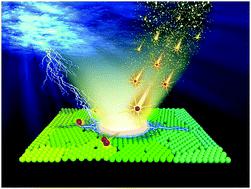当前位置:
X-MOL 学术
›
Energy Environ. Sci.
›
论文详情
Our official English website, www.x-mol.net, welcomes your
feedback! (Note: you will need to create a separate account there.)
Boosting the oxygen evolution reaction using defect-rich ultra-thin ruthenium oxide nanosheets in acidic media
Energy & Environmental Science ( IF 32.4 ) Pub Date : 2020-11-13 , DOI: 10.1039/d0ee01960g Zhi Liang Zhao 1, 2, 3, 4 , Qi Wang 1, 2, 3, 4 , Xiang Huang 2, 3, 4, 5 , Qi Feng 1, 2, 3, 4 , Shuang Gu 3, 4, 6, 7 , Zhen Zhang 1, 2, 3, 4 , Hu Xu 2, 3, 4, 5 , Lin Zeng 2, 3, 4, 8 , Meng Gu 1, 2, 3, 4 , Hui Li 1, 2, 3, 4, 9
Energy & Environmental Science ( IF 32.4 ) Pub Date : 2020-11-13 , DOI: 10.1039/d0ee01960g Zhi Liang Zhao 1, 2, 3, 4 , Qi Wang 1, 2, 3, 4 , Xiang Huang 2, 3, 4, 5 , Qi Feng 1, 2, 3, 4 , Shuang Gu 3, 4, 6, 7 , Zhen Zhang 1, 2, 3, 4 , Hu Xu 2, 3, 4, 5 , Lin Zeng 2, 3, 4, 8 , Meng Gu 1, 2, 3, 4 , Hui Li 1, 2, 3, 4, 9
Affiliation

|
Developing low cost and highly active catalysts for the oxygen evolution reaction (OER) in an acidic medium is urgently indispensable for proton exchange membrane water electrolyzers (PEMWEs). Herein, we have prepared ultra-thin RuO2 nanosheets (RuO2 NSs) using a simple molten salt method. The as-prepared RuO2 NSs with a thickness of 1–2 nm possess abundant defects. Toward the OER, the RuO2 NSs achieve an extremely low overpotential of 199 mV at a current density of 10 mA cmgeo−2 with a loading of 125 μg cmgeo−2. Furthermore, the RuO2 NSs exhibit specific and mass activities of up to 0.89 mA cmoxide−2 and 0.52 A mgRu−1 at 1.46 V vs. RHE, which are 14.9 and 80.6 times enhanced in specific and mass activity as compared to the commercial RuO2 nanoparticles, respectively. In a homemade PEMWE, with RuO2 NSs as the OER catalyst, the electrolyzer achieves a current density of 0.93 A cm−2 at a cell voltage of 1.65 V without iR drop correction, which is 3 times larger than that of the commercial RuO2 catalyst (0.31 A cm−2). Density functional theory calculations indicate that the Ru vacancy on the RuO2 NS surfaces significantly weakens the binding energy of O* with respect to that of OOH*, which decreases the energy cost in the transformation from O* to OOH*, and thus dramatically enhances the OER performance. The unique defect-rich structure and outstanding performance demonstrate that the RuO2 NSs possess great potential for developing high-performance PEMWEs.
中文翻译:

在酸性介质中使用富含缺陷的超薄氧化钌纳米片促进氧气释放反应
对于质子交换膜水电解器(PEMWE)而言,迫切需要开发用于酸性介质中氧释放反应(OER)的低成本和高活性催化剂。本文中,我们使用简单的熔融盐方法制备了超薄RuO 2纳米片(RuO 2 NSs)。制备的厚度为1-2 nm的RuO 2 NS具有大量缺陷。朝向OER,所述的RuO 2奈米实现极低的超电势199毫伏在10mA厘米的电流密度地理-2与125微克厘米装载地理-2。此外,RuO 2 NSs的比活和质量活度高达0.89 mA cm氧化物-2相对于RHE,在1.46 V时的0.52 Amg Ru -1和比RuU 2纳米颗粒的比活性和质量活性分别提高了14.9和80.6倍。在以RuO 2 NSs作为OER催化剂的自制PEMWE中,该电解槽在1.65 V的电池电压下可实现0.93 A cm -2的电流密度,而无需进行iR降落校正,这是商用RuO 2的3倍催化剂(0.31A cm -2)。密度泛函理论计算表明,RuO 2上的Ru空位与OOH *的结合能相比,NS表面显着削弱了O *的结合能,从而降低了从O *转变为OOH *的能量成本,从而显着提高了OER性能。独特的富缺陷结构和出色的性能表明,RuO 2 NS具有开发高性能PEMWE的巨大潜力。
更新日期:2020-11-23
中文翻译:

在酸性介质中使用富含缺陷的超薄氧化钌纳米片促进氧气释放反应
对于质子交换膜水电解器(PEMWE)而言,迫切需要开发用于酸性介质中氧释放反应(OER)的低成本和高活性催化剂。本文中,我们使用简单的熔融盐方法制备了超薄RuO 2纳米片(RuO 2 NSs)。制备的厚度为1-2 nm的RuO 2 NS具有大量缺陷。朝向OER,所述的RuO 2奈米实现极低的超电势199毫伏在10mA厘米的电流密度地理-2与125微克厘米装载地理-2。此外,RuO 2 NSs的比活和质量活度高达0.89 mA cm氧化物-2相对于RHE,在1.46 V时的0.52 Amg Ru -1和比RuU 2纳米颗粒的比活性和质量活性分别提高了14.9和80.6倍。在以RuO 2 NSs作为OER催化剂的自制PEMWE中,该电解槽在1.65 V的电池电压下可实现0.93 A cm -2的电流密度,而无需进行iR降落校正,这是商用RuO 2的3倍催化剂(0.31A cm -2)。密度泛函理论计算表明,RuO 2上的Ru空位与OOH *的结合能相比,NS表面显着削弱了O *的结合能,从而降低了从O *转变为OOH *的能量成本,从而显着提高了OER性能。独特的富缺陷结构和出色的性能表明,RuO 2 NS具有开发高性能PEMWE的巨大潜力。











































 京公网安备 11010802027423号
京公网安备 11010802027423号